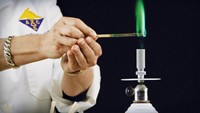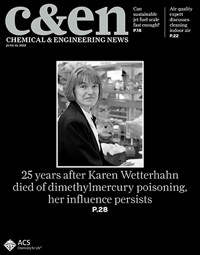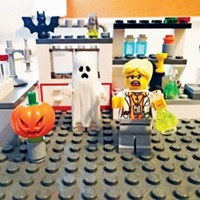Advertisement
Grab your lab coat. Let's get started
Welcome!
Welcome!
Create an account below to get 6 C&EN articles per month, receive newsletters and more - all free.
It seems this is your first time logging in online. Please enter the following information to continue.
As an ACS member you automatically get access to this site. All we need is few more details to create your reading experience.
Not you? Sign in with a different account.
Not you? Sign in with a different account.
ERROR 1
ERROR 1
ERROR 2
ERROR 2
ERROR 2
ERROR 2
ERROR 2
Password and Confirm password must match.
If you have an ACS member number, please enter it here so we can link this account to your membership. (optional)
ERROR 2
ACS values your privacy. By submitting your information, you are gaining access to C&EN and subscribing to our weekly newsletter. We use the information you provide to make your reading experience better, and we will never sell your data to third party members.
Synthesis
Newscripts
A Bug Saver Remembers, Kansai Airport Uses Microwave, Chemistry down and Dirty
by BY K. M. REESE
August 16, 2004
| A version of this story appeared in
Volume 82, Issue 33
A bug saver remembers
Werner R. Haag writes from Sunnyvale, Calif., that his memory was stirred recently by lines he encountered in an anthology of limericks.
Haag says that in the early 1970s, he had a summer job with the New Jersey health department. He worked at the time for the state's encephalitis monitoring program. He and his colleagues would permit mosquitoes to accumulate in " 'resting boxes' overnight, knock them out with chloroform, suck them up in a tube, and blow them into cup-size cages." The mosquitoes would wake up in 10 minutes, Haag says, "but in the meantime we exposed ourselves to a lot more chloroform than would be allowed these days."
Haag was thus stirred when he read the following limerick by an anonymous author:
A mosquito was heard to complain
That a chemist had poisoned his brain
The cause of his sorrow
Was Para-dichloro--
Diphenyltrichloroethane.
Kansai airport uses microwave
Robert J. (Bob) Nash writes from Webster, N.Y., that Kansai International Airport, Osaka, Japan, has introduced microwave devices to conduct security checks on plastic bottles that passengers carry aboard airplanes (Japan Times , July 27). The small device, the Times says, "emits microwaves into a bottle placed on it and analyzes the reflected waves. A red light and alarm go off if flammable substances are inside, while a green light indicates there is no problem. The procedure only takes about a second and requires the container to be only about 20% full."
The Kansai airport operator says it expects the microwave method to help reduce departure-area congestion. The operator also hopes the new method will help improve sanitary aspects of the current method, which was introduced in March 2003. In that method, inspectors open and sniff the plastic bottles. Kansai plans to use the microwave devices on a trial basis until October at both international and domestic terminals.
Meanwhile, Nash reflects, "Let's hope that the Kansai Kops [sic] were only using sniff tests to detect nail-polish remover, aftershave lotion, etcetera, and not sarin as synthesized by the chemically bent, infamous Aum Shinrikyo cult in Japan!"
Nash says that the sniff-it detection approach "reminds me of my pre-spectral 1960s undergraduate days--in those days the organic laboratory class was designed to 'teach' the principles of organic chemistry via hands-on synthesis exercises (on the benchtop--no fume cupboards or safety glasses in those days!) and via the qualitative analysis of 'unknown' organic compounds. The latter exercises were strictly based on first-order physical and chemical tests (such as appearance, melting point, flame tests, and the synthesis of verifiable derivatives). Invariably, of course, the first step in any analysis was the zero-order 'sniff test'--to identify classes such as alcohols, esters, amines, amides, aliphatics, and of course aromatics--fortunately, we'd progressed beyond the 'taste-it' test that had claimed so many past brilliant chemical pioneers!
"Anyway, the undisputed champion chemical sleuth in my class had the advantage of several years of industrial experience behind him, and the chemistry staff was forever trying to present him with obscure compounds, but generally his first sniff was enough to send him off to 'Beilstein's Handbuch der Organischen Chemie' in search of confirmatory derivatives."
Nash goes on, "For general amusement, we also used to arrange 'sniff quizzes'--all the usual esters, etcetera, plus the infamous phenyl isocyanide (some folks thought it had a honeylike odor, while others reacted with violent vomiting) onward toward 3-methyl indole and other such nasties! But I digress."
Chemistry down and dirty
Allen A. Denio mailed recently from Newark, Del., a picture from the Wilmington News Journal captioned: "Afghan boys take chemistry tests Wednesday at Sayed High School, near Kabul. Most schools in Afghanistan operate in austere conditions since the collapse of the Taliban." Everybody's sitting outside on the ground, and it sure looks dusty.






Join the conversation
Contact the reporter
Submit a Letter to the Editor for publication
Engage with us on Twitter